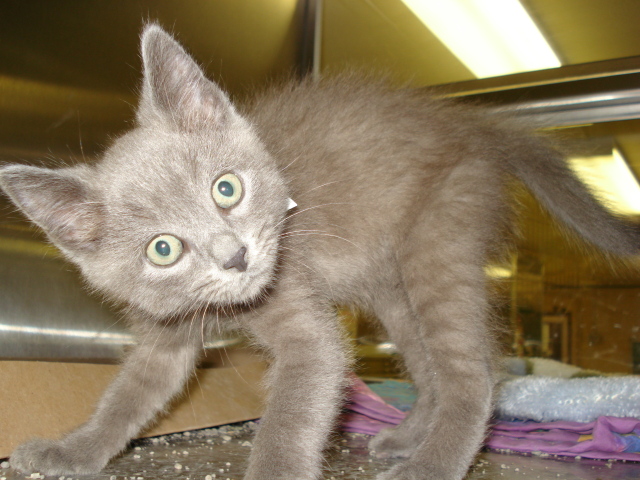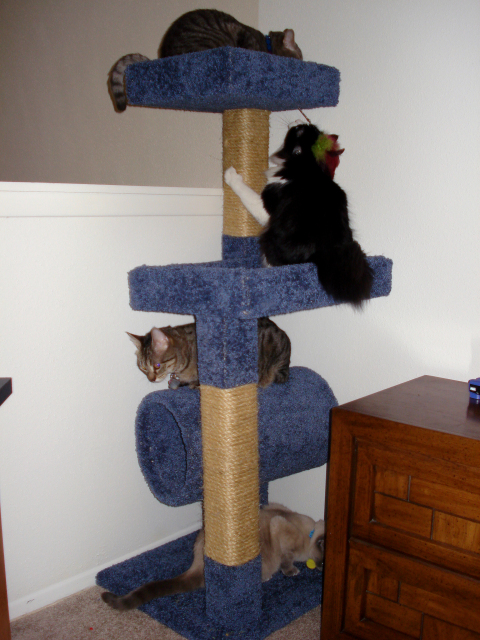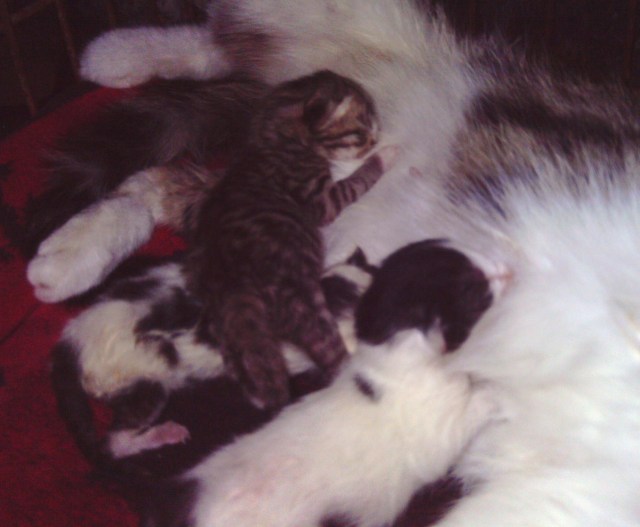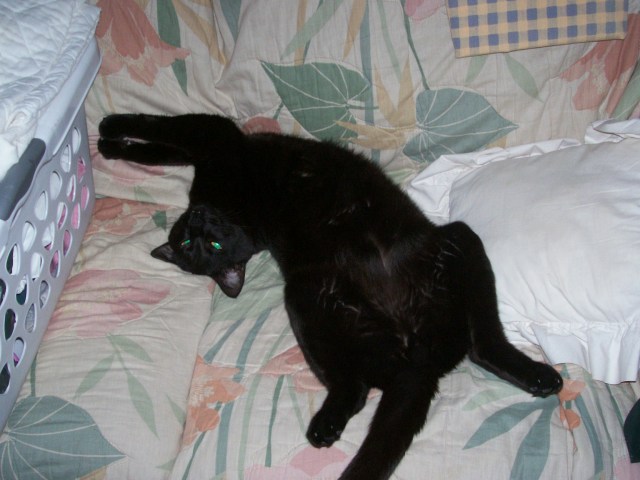QuestionA friend of me and my husbands was told a week ago that a cat they had adopted out to a friend was going to be put down because she was biting her owner. Since we not only knew this cat as a kitten but also adopted her brother, we went and got the cat from her. She is a tortie dsh, about 10 months old, was spayed before first heat. Unfortunetly, the former- owner also got her declawed, because as the lady said she scratched her. She was a kitten! So now she bites. I mean we can't get anywhere near her. I've had her for 4 days, in a room by herself with lots of toys and other amusement, and I still can't get into the room without having to wear gloves and very thick clothes. She was a sweet, playful kitten, and her brother is a sweetheart. What do you think could have caused this? I just will not be able to live with myself if I can't help this cat. Everything is a trigger to her, so behavior modification is going to be hard if not impossible. Please help! The shelters around here(Bis. ND) will not take her, they dont have the resources to rehabilitate her.
Answer
 Ash, 7 week old Russia
Ash, 7 week old Russia
Hi Mandolynn,
I am sorry to hear about your troubles, but am very grateful that you were willing to take this on and help her. Unfortunately, this scenario is all too common. Kittens are kittens, and will play and bite, and there are very basic behavioral modification techniques you can use to help them through this. When I was the Cat Adoptions Team Leader for a local shelter, I had a kitten by the name of Ash who I had to do this very technique with. He was highly dominant and had been taken from his mother and siblings far too young, at around 4 weeks old we think, and so he had not been taught proper social and play behavior. You couple that with a dominant stubborn personality and you have a hard case on your hands. It took me 5 weeks of rehabilitation to extinct the biting, spending about an hour each day 5-6 days a week. But once you do, it's so rewarding. He remains one of my favorite cats, to the point that he is one I would've considered adopting based on his energy and spirit. I have a gift in that I can see what lies beneath--the true nature and essence of each cat, and there was something special about that little guy. I also had a foster, Cosmo, I did the same procedure with, and it took me about 4 weeks with him, however I spent much more time with him as I had him at home with me. He came in to the shelter underweight at 5 weeks old, so he had to go into foster care.
On the same token, when you declaw any cat (I understand that you were not the one who did this), you are removing their first line of defense, as well as cutting off their toes. Cats walk on their toes, so this is always a very painful process and horrible way to live. Furthermore, some vets do not do the procedure properly, which can contribute to more excruciating pain, and in my experience, the more dominant the personality of the cat, the worse the behavioral changes are after being declawed. Then you add to that now this cat is in a new, strange environment with people she did not grow up trusting. So you basically are going to have to go back to basics here and treat her like she's an 8-week-old kitten you just adopted.
I believe that any animal can be rehabiliatated if you apply the right knowledge at the right time in the right way, and you are always calm, patient, and consistent. Now this can test even the best people, so please be aware that this process may take for her several months. Once you can get her to a point where she has developed a relationship with you based on trust and respect, and feels comfortable in her new environment, things will get smoother.
You are already doing right by keeping her in her own room. She is not to come out or see her brother until she is fully rehabilitated, or you are just going to set yourself back. Keep in mind animals that have been from home to home are slower to trust and thereby slower to feel secure and safe in their current environment. Start over from day one. Go into the room and just be--just sit, share your calm energy, perhaps talk to her--about anything. Let her approach you, smell you, whatever she wants to do, but don't touch her. If she goes to bite you, freeze your hand/arm, stiffen up, and yell in a high-pitched, sharp tone "Ouch!" You are using body language and a sound that triggers a natural instinct to get their attention and snap them out of it. Every cat I have every used this method with will eventually go to lick you instead, at which time you take a happy, calm tone and praise them. In these initial stages, I would still say refrain from touching her. You can pet her gently to praise her at these times after about a week or whenever you feel she has progressed enough that she trusts you.
Do not leave food down, rather feed her 1/4 cup three times a day. This is for several reasons. First, free-feeding leads to the early deterioration of organs as well as obesity. Unfulfilled cats will eat because they are bored, unhappy, stressed, or even just because it's there, which is very unhealthy. Second, having consistent feeding times builds trust as well as strengthens your bond because you are providing them with one of their needs. They associate you with their food, which is always a positive thing. Start with a good, holistic food. I'm not sure if you've heard of HALO, but I highly recommend checking out their website (http://www.halopets.com) and reading why their food is above and beyond any other. Most people are unaware of the dangers of commercial pet food (pretty much any food that does not say organic or holistic on the bag) which are primarily that these companies continue to make these pet foods with dyes, chemicals, and preservatives that have been *proven* to cause cancer, Diabetes, Hyperthyroidism, urinary blockages, and a variety of other conditions ailing our pets and leading them to an early grave. Please see the following articles for more detailed information:
What's Really in Pet Food?
http://www.bornfreeusa.org/facts.php?more=1&p=359
Gluten and Toxins in Pet Food
http://www.celiac.com/articles/1129/1/Gluten-and-Toxins-in-Pet-Foods-Are-they-Po...
Beyond this, you want to make sure that you provide her with a soft, natural litter. Declawed cats frequently stops using their litter box because the process of pawing is so painful. I recommend using a natural alternative such as wheat or corn. I switched mine to Swheat Scoop and could NOT be happier. The wheat is an agricultural byproduct of harvesting wheat for human consumption, and is chopped up to use as litter, reducing agricultural waste. It makes for a wonderful litter because their are no harmful chemicals such as sodium bentonite found in clumping clay litter which causes respiratory distress from the dust as well as is harmful to their digestive systems when they groom the residue from their paws. It can solidify in their intestines and kill them in worst case scenarios. Furthermore, the wheat litter is biodegradable and can be flushed if broken in to small pieces.
Next, make sure that she has an upright sisal rope scratch post. Yes, even declawed cats need a post. They still possess the natural instinct to claw and need a place to do so to feel fulfilled. Not only do they claw to shed their nails, but they do so to strengthen and stretch their muscles, which is something they also accomplish by climbing. Next, make sure that you have both toys she can play with alone such as toy mice or waded up paper balls (two of my cats favorite) as well as some with you, such as a leather tassle cat dangler. Stay away from feather toys as they can swallow the spine of the feather and get it lodged in their throat. Each cat has its own likes and dislikes, and the sooner you figure hers out, provide her with what she likes, and avoid what she doesn't, the faster she will trust you and develop a strong bond.
Also keep in mind her resentment and frustration is more accelerated now because of her age, continuing to grow and experience bodily changes. She will calm down with age. My highly active, dominant female Phoenix finally started to calm down, relax more, and become sweet when she got to be about 1 year 9 months old. I know this may seem like a lifetime away, but you will make progress with these techniques, and as she grows and matures, she will begin to calm down. The best way to provide for her is to find what helps her get out her energy and thereby a lot of her frustration and do it daily. Work to build a bond with her, and always provide her necessities, keep her box clean, and interact with her daily. You can also try mixing some catnip into her wet food when you feed it in the evenings; while catnip is a stimulant when inhaled, it acts as a sedative when ingested, so that may help you with sessions with her after her PM feeding.
I wish you the best of luck, and please keep me updated on how things are going and if you have any further questions or concerns. Thank you for stepping up and taking her in--not many people have a big enough heart to do that, and it warms my heart to find there are a few more people out there like me. Good luck!
Best regards,
Holly Martin


 Cat and Dog Introductions
QuestionHi!
I recently acquired a tortie; although I wa
Cat and Dog Introductions
QuestionHi!
I recently acquired a tortie; although I wa
 cat vitamins; valerian feline;; NuVet health pets; wholistic Feline;
QuestionHi, I have a mostly indoor cat - sh
cat vitamins; valerian feline;; NuVet health pets; wholistic Feline;
QuestionHi, I have a mostly indoor cat - sh
 Labor Stalled?
QuestionQUESTION: Recently a very pregnant cat adopted
Labor Stalled?
QuestionQUESTION: Recently a very pregnant cat adopted
 cat breed?
QuestionQUESTION: I have a solid black male cat, and I
cat breed?
QuestionQUESTION: I have a solid black male cat, and I
 Litter Box Behaviour
Question
All Kitties
Hello!
Im writing to you fo
Litter Box Behaviour
Question
All Kitties
Hello!
Im writing to you fo